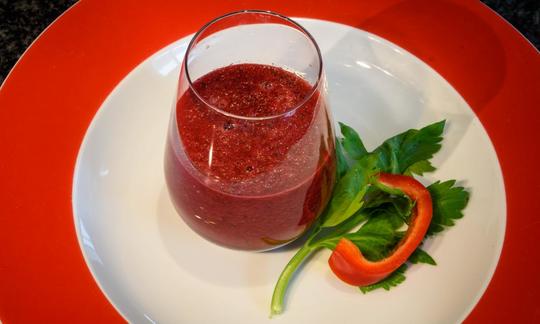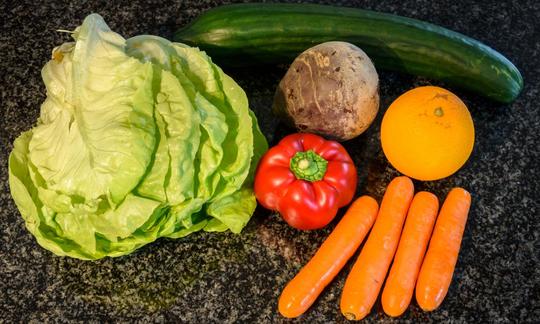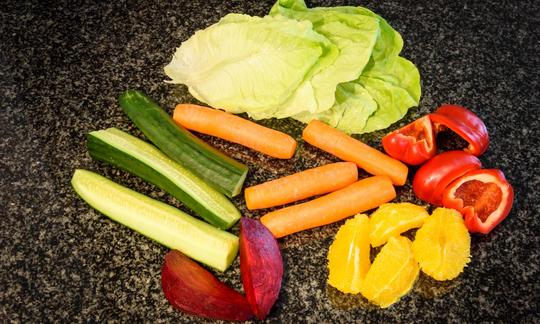Colorful smoothie with beetroot and orange
raw-vegan
Ingredients (for servings, )
| 1 | Sweet peppers, red, raw (organic?) (5.8 oz) |
| 4 | Carrots (carrots), raw (organic?) (8.6 oz) |
| 1 | Oranges, raw (organic?) (4.6 oz) |
| 1 small | Beetroot, raw (organic?) (3.5 oz) |
| 1 | Cucumbers, raw (organic?) (16 oz) |
| 5 leaves | Lettuce, (Butterhead group), raw, organic? (1.3 oz) |
Equipment
- blender
- juicer
- vegetable peeler
Type of preparation
- chop or grind
- food preparation without heating
- blend
- juice
- peel
Preparation
Wash the bell peppers and carrots, cut them into large pieces and put them in the juicer.
If you use organically grown vegetables, you do not need to peel them.
Peel the orange. Peel the beetroot with a vegetable peeler and cut into small pieces.
When handling beetroot, it is advisable to wear disposable gloves to avoid discoloration of your hands.
Wash the cucumber and cut into large pieces. Put it in a blender with the remaining ingredients and the juice from the bell pepper and carrot and mix on the highest setting until you have a homogeneous smoothie.
When preparing or garnishing the colorful smoothie, foods that have a complementary color spectrum, such as green lettuce leaves or leeks, are particularly suitable.
|
Nutritional Information per person
Convert per 100g
|
2000 kcal | |
|---|---|---|
| Energy | 164 kcal | 8.2% |
| Fat/Lipids | 1.00 g | 1.4% |
| Saturated Fats | 0.18 g | 0.9% |
| Carbohydrates (inc.dietary fiber) | 38 g | 14.0% |
| Sugars | 23 g | 25.2% |
| Fiber | 9.4 g | 37.8% |
| Protein/Albumin | 5.1 g | 10.2% |
| Cooking Salt (Na:131.5 mg) | 334 mg | 13.9% |
| Essential micronutrients with the highest proportions | per person | 2000 kcal | |
|---|---|---|---|
| Vit | Vitamin C (ascorbic acid) | 156 mg | 195.0% |
| Vit | Vitamin A, as RAE | 1'198 µg | 150.0% |
| Vit | Vitamin K | 77 µg | 103.0% |
| Vit | Vitamin B9, B11 (Folate, as the active form of folic acid) | 164 µg | 82.0% |
| Elem | Potassium, K | 1'224 mg | 61.0% |
| Vit | Vitamin B6 (pyridoxine) | 0.59 mg | 42.0% |
| Prot | Threonine (Thr, T, irreversibly transaminated) | 0.35 g | 38.0% |
| Min | Manganese, Mn | 0.66 mg | 33.0% |
| Vit | Vitamin B1 (Thiamine) | 0.27 mg | 25.0% |
| Vit | Vitamin B5 (Pantothenic acid) | 1.5 mg | 24.0% |
Detailed Nutritional Information per Person for this Recipe
The majority of the nutritional information comes from the USDA (US Department of Agriculture). This means that the information for natural products is often incomplete or only given within broader categories, whereas in most cases products made from these have more complete information displayed.
If we take flaxseed, for example, the important essential amino acid ALA (omega-3) is only included in an overarching category whereas for flaxseed oil ALA is listed specifically. In time, we will be able to change this, but it will require a lot of work. An “i” appears behind ingredients that have been adjusted and an explanation appears when you hover over this symbol.
For Erb Muesli, the original calculations resulted in 48 % of the daily requirement of ALA — but with the correction, we see that the muesli actually covers >100 % of the necessary recommendation for the omega-3 fatty acid ALA. Our goal is to eventually be able to compare the nutritional value of our recipes with those that are used in conventional western lifestyles.
| Essential fatty acids | per person | 2000 kcal |
|---|---|---|
| Alpha-Linolenic acid; ALA; 18:3 omega-3 | 0.06 g | 3.0% |
| Linoleic acid; LA; 18:2 omega-6 | 0.29 g | 3.0% |
| Essential amino acids | per person | 2000 kcal |
|---|---|---|
| Threonine (Thr, T, irreversibly transaminated) | 0.35 g | 38.0% |
| Tryptophan (Trp, W) | 0.05 g | 22.0% |
| Isoleucine (Ile, I) | 0.21 g | 17.0% |
| Lysine (Lys, K, irreversibly transaminated) | 0.29 g | 16.0% |
| Phenylalanine (Phe, F) | 0.21 g | 14.0% |
| Valin (Val, V) | 0.22 g | 14.0% |
| Leucine (Leu, L) | 0.28 g | 12.0% |
| Methionine (Met, M) | 0.07 g | 7.0% |
| Vitamins | per person | 2000 kcal |
|---|---|---|
| Vitamin C (ascorbic acid) | 156 mg | 195.0% |
| Vitamin A, as RAE | 1'198 µg | 150.0% |
| Vitamin K | 77 µg | 103.0% |
| Vitamin B9, B11 (Folate, as the active form of folic acid) | 164 µg | 82.0% |
| Vitamin B6 (pyridoxine) | 0.59 mg | 42.0% |
| Vitamin B1 (Thiamine) | 0.27 mg | 25.0% |
| Vitamin B5 (Pantothenic acid) | 1.5 mg | 24.0% |
| Vitamin B2 (Riboflavin) | 0.27 mg | 20.0% |
| Vitamin E, as a-TEs | 2.3 mg | 20.0% |
| Vitamin B7 (Biotin, ex vitamin H) | 9.9 µg | 20.0% |
| Vitamin B3 (Niacin) | 2.6 mg | 17.0% |
| Essential macroelements (macronutrients) | per person | 2000 kcal |
|---|---|---|
| Potassium, K | 1'224 mg | 61.0% |
| Phosphorus, P | 154 mg | 22.0% |
| Magnesium, Mg | 75 mg | 20.0% |
| Sodium, Na | 131 mg | 16.0% |
| Calcium, Ca | 123 mg | 15.0% |
| Essential trace elements (micronutrients) | per person | 2000 kcal |
|---|---|---|
| Manganese, Mn | 0.66 mg | 33.0% |
| Copper, Cu | 0.23 mg | 23.0% |
| Iron, Fe | 2.1 mg | 15.0% |
| Zinc, Zn | 1.2 mg | 12.0% |
| Selenium, Se | 1.7 µg | 3.0% |
| Iod, I (Jod, J) | 5.1 µg | 3.0% |
| Fluorine, F | 6.9 µg | < 0.1% |
The beetroot not only gives this colorful smoothie a beautiful color, complementing the fruity orange, but also contains many healthy ingredients.
Beetroot: Beetroot owes its red colour to the pigment betanin. Because of its red juice, it has long been considered a blood-forming medicinal plant. However, it is not the pigment that is directly responsible for this, but rather other ingredients. Due to its high vitamin B, potassium, iron and, above all, folic acid content, beetroot is a very healthy vegetable.
However, animal iron is easier to absorb than plant iron, which is why vegans should pay more attention to ensuring they have a good supply.
The folic acid content depends heavily on the storage and processing conditions. It is sensitive to both light and heat. Depending on the method of preparation, some of the vitamins contained are lost. It is therefore best to eat beetroot raw or to use gentle preparation methods.
Caution: People who are prone to the formation of kidney stones should only eat beetroot in moderation, as it is rich in oxalic acid. Beetroot can also contain significant amounts of nitrates and, if stored incorrectly, can form nitrites. Nitrites are unhealthy, as they can lead to reduced oxygen transport in the blood.
Eating large amounts of beetroot can cause urine and intestinal excretions to temporarily turn reddish-brown, but this is completely harmless.
Difference between juice and smoothie: While juicing produces a liquid juice, a smoothie is more like a puree. In contrast to juice, smoothies use the whole fruit, sometimes the peel too. The basis of smoothies is therefore fruit pulp or fruit puree, which can be diluted depending on the recipe to achieve a creamy consistency.
From a nutritional point of view, smoothies have the advantage over juices that no ingredients are lost. When you drink a smoothie, you drink the fiber as well. Fiber is very important for intestinal health. It also ensures that the sugar from the fruit enters the metabolism more slowly and gently than with juice freshly squeezed from a juicer. This means that you feel fuller after drinking a smoothie for longer than with juice. This smoothie is actually a combination of juice and smoothie.
Choosing the carrots: When choosing the carrots, make sure they are of the best quality. They should be as fresh and young as possible. Any green parts should be removed. If the carrots are not sweet enough, you can increase the amount of orange or add apple. This will give you a healthy and fruity smoothie.
Beetroot ratio: The amount of beetroot should not exceed 50 g per person. Depending on the selection, they can be too bitter and earthy and overpower the taste of the smoothie.
Beetroot preparation: If stains occur during preparation, hot water should be used as quickly as possible. Since the dye is not very heat-resistant, discoloration can usually be removed easily. Since the vitamins are also not very heat-resistant, it is recommended to enjoy beetroot raw. You can also eat the green parts of the beetroot.
Vitamin C effect: Since vitamin C can improve the utilization of plant iron, it is best to enrich your beetroot dish with vitamin C-rich orange juice as is the case in this recipe.
Romaine lettuce: Instead of lettuce, you can also use romaine lettuce.
Consistency: If you prefer a more liquid drink, you can either increase the amount of cucumber or orange, in addition to diluting it with water, for example, or juice other or all of the ingredients instead of putting them in the blender. By reading the above text, you can weigh up the pros and cons of smoothies and juices. We found this interesting compromise to be the best combination in the test, even though you have to clean two machines afterwards.
Using pomace: The pomace from carrots and beetroot can be pureed together with avocado and almonds or turned into vegetarian meatballs or patties with a little rice, herbs and onions. Of course it is also good for organic compost, but it is almost too good for that.








